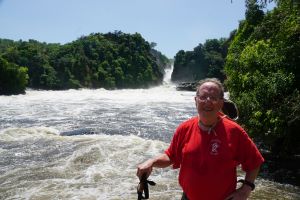May 14,2018
I’ll be leading almost 30 boys to Scout camp in mid-June, so what I’ve done the past two days might serve as good preparation.

For one thing, we ate common meals at the Lodge. Admittedly, there was no Paul Bunyan breakfast (thankfully!); instead, we had buffets that included a lot of Indian food. Part of the explanation for the Uganda Chapati and Dal and baked on the spot in a tandoor oven naan (!) is the Indian influence that started in the British period; even more helpful in understanding the fare is that the Lodge is owned by the richest Indian in Uganda. And, as we stop at historic Galena on our way home from camp, we stopped for lunch at a restaurant hotel built by the Kenya Uganda Railway and Harbours in 1923. That hotel had as guests Humphrey Bogart and Katherine Hepburn during the filming of The African Queen.
Speaking of the African Queen, Sunday morning we continued our waterfront activities (we had a few hours downtime Saturday; I did laps in the pool. Several others discovered that being near the equator and in the sun can be a painful experience). While swimming in the Nile might have been attractive, one look at the 14 foot crocs lining the shore and remembering Captain Hook, and the herds of hippos, the animal that kills more Africans than any non-human animal, left me thinking I’ll do the mile swim at camp instead.
We went upriver on the African Queen (you knew at some point there was a reason to mention the movie; not THE African Queen, but An African Queen)  to Murchison Falls (Headline: Murchison Falls but no one was hurt), the 200 or so foot high waterfall that gives the park its name. Docking near the falls, we hiked about 2 miles to the summit where we could overlook the falls, a powerful cascade that is one of many obstacles on the river’s journey to the delta around Alexandria. That was our hike for the day.
to Murchison Falls (Headline: Murchison Falls but no one was hurt), the 200 or so foot high waterfall that gives the park its name. Docking near the falls, we hiked about 2 miles to the summit where we could overlook the falls, a powerful cascade that is one of many obstacles on the river’s journey to the delta around Alexandria. That was our hike for the day.
Returning to the Lodge, we had a speaker from the Uganda Wildlife Administration, who told us something about the history of conservation in Uganda, and the challenges he faces in running the area. Conservation/tourism is important to the economy (it’s the biggest business in the world); ¼ of the nation is in either national parks or reservations. Ironically, in the 1950s, Uganda’s parks had more visitors than any other park in Africa. The disastrous poaching civil wars, as I mentioned, killed people and animals. For example, the herd of 14000 elephants dwindled to 300; it’s now about 1400. One challenge to this park is that commercially viable oil deposits have been found under the park, and, like so many similar areas around the world, the extraction (if it happens) needs to be monitored carefully. He described meetings and agreements that were designed to extract but protect; one feature I remembered is that a pipeline connected to a refinery would have to be underground—those same elephants would crush it. He also discussed, and we ran across an armed patrol on one of our game drives. He said it’s become less of a problem because many countries have banned the importation of ivory.
On our way back to Kampala, we got another taste of the biodiversity of Murchison Falls National Park, and we continued to work on our Mammals, Nature and Environmental Science badges with a visit to a jungle for a chimpanzee trek. Donning rubber boots, we plunged into a dense jungle; the object—the sighting of our closest relatives. For about an hour, our guide took us through the brush looking for the chimps.  I was afraid all we’d get for our troubles were pictures of knuckle prints on the ground (that’s how they travel). Suddenly I heard a racket that I thought was some inconsiderate student group—that’s what it sounded like. There was also a thump, like a chimpanzee thumping his chest. We headed toward where the guide thought they were moving, when, lo and behold, we spotted three or four. One ran across the floor of the jungle in front of us, and when I get the video, I’ll put it on Facebook, but spent the better part of the next two hours craning to get a glimpse of the mammals in the treetops. You could tell where they were from moving branches, falling leaves, and the sounds.
I was afraid all we’d get for our troubles were pictures of knuckle prints on the ground (that’s how they travel). Suddenly I heard a racket that I thought was some inconsiderate student group—that’s what it sounded like. There was also a thump, like a chimpanzee thumping his chest. We headed toward where the guide thought they were moving, when, lo and behold, we spotted three or four. One ran across the floor of the jungle in front of us, and when I get the video, I’ll put it on Facebook, but spent the better part of the next two hours craning to get a glimpse of the mammals in the treetops. You could tell where they were from moving branches, falling leaves, and the sounds.
I saw a little one. You might say he was a chimp off the old block. Oh, you don’t have to. I did.